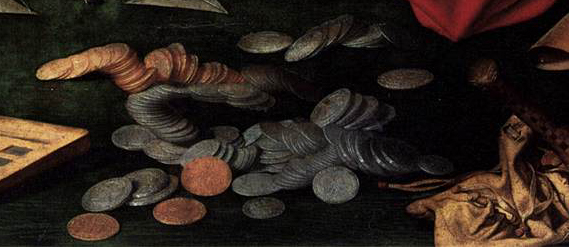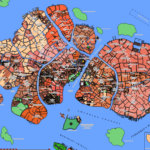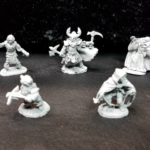I’ve sometimes wondered when I’ve played Dungeons and Dragons and other similar fantasy role-playing games, how much could I relate the costs of goods and services in game with expenses to which I am familiar in the real world. Gary Gygax mentions in the first edition AD&D Dungeon Master’s Guide that the cost of goods and services in the D&D world is inflated due to the influx of adventurers’ gold coin, comparable to the inflated price of eggs in the gold rush. But in the world of Asdar, not every place is stuffed with adventurers dumping their latest hauls of loot into the local economy. Additionally, the great size of the largest cities in the populous Pallathantic Region in 2750 AS would effectively dampen the effect of the influx of coin.

The technology and monetary practices of the West are somewhere between a medieval fantasy game and the real world. In a medieval economy, manufactured goods are much cheaper than their modern counterparts because wages are very low. The exception to this is for very skilled labor, but even then I suppose it could be less than the modern world. The artisans who did the vast, elaborate, and unending enrichment of the interior of the Alhambra would have cost an exorbitant fortune in today’s economy. Additionally, modern Asdar (ca 2750 AS) enjoys a certain degree of mechanized manufacturing thanks to titancraft technology. In the modern world, countries use fiat currency. In the world of Asdar, all currencies are backed up by gold or silver, even if paper is exchanged. The gold coin is the de facto standard of wealth in D&D and Pathfinder. In Asdar, the gold coin is the most widely used currency for purchases of significant value, such as a horse, a house, the skills of a very costly mercenary or master craftsman.
In the real world, the price of gold fluctuates quite a lot, especially as it has in the past six years. As of this evening today, the cost of one troy ounce of gold is $1315USD. For some time during my life, the price of gold was more or less $400USD. At one time in the past six years, the price shot up to nearly $2000USD a troy ounce. So, even if I convert a gold coin into US dollars, the amount can vary. Anyone who has regularly bought groceries, knows that the cost of food has virtually doubled in the past six years (2008 to 2014) as well.
Sorry, but I have to get nit-picky here. According to PF (Pathfinder) Core Rulebook, “The standard coin weighs about a third of an ounce (50 to the pound).” Since 16 times three makes 48, we know they mean the standard avoirdupois ounce as an avoirdupois ounce is 1/16 of a pound. This also means that a gold coin in the PF Universe is smaller than a US gold dollar which 1 troy ounce. This compares well to the ancient world where the gold coin of the Romans (aureus) was also smaller than a troy ounce. A troy ounce is 1/12 of a pound. A troy ounce is 1.09714 avoirdupois ounces which means there are 17.55424 troy ounces in a US Pound which I assume is the same as the imperial pound. That means a pound of gold today on the commodities market is worth $23,083USD. At the old price of $400USD, a pound of gold would have been worth about $7022USD. A gold coin in the PF Universe is 1/48 a US pound, so that means it would 1/48 of $23,083USD which is about $481USD. If the old average of $400USD were in force, a gold piece would be worth about $146USD.
So $480US (353 Euros) for a gold piece. But this is really not a perfect comparison. First of all, gold today is not currency. It’s a commodity. Secondly, the comparison assumes, incorrectly, that the availability of gold in the real world is the same as it is in the PF universe (or in the world of Asdar, for that matter). Even in the real world, gold can have differing degrees of availability in different regions and in different historic periods. Compare the availability of gold in pre-Columbian Peru, medieval Spain, post-Pizarran Spain, Medici Florence, medieval Hungary, in the Amarna period in Egypt versus the Amarna period in Babylonia, Alaska during the gold rush, and in the US today.
In the world of Asdar, gold is not any rarer than it is in the real world. Even if I ‘guestimate’ that one standard gold coin in the Pallathantic Region around 2740 AS is worth about $500USD, I still cannot instantly calculate the price of goods and services in the world of Asdar. Consider a house. Modern manufacturing technology and cheap labor from Mexico means that your house in the US could be comparably cheaper than the rough equivalent would be in the world of Asdar. Additionally, a house in the modern world would have technological conveniences (central heating, central cooling, electricity, natural gas, possibly solar power) which most homes in Asdar would not have. Indoor plumbing, municipal water supply, and sewage disposal are probably the only thing they would have in common in this regard, and only in the large, advanced cities. It is possible that some houses could have natural gas (“essence”), but that would only be in larger cities. So for this reason, I can’t really calculate the price of a house with scientific certainty. As with all real estate, the location (and thus the desirability) is the most widely varying factor. An old, but well-kept three-bedroom penthouse in the nicest neighborhood in Trevirs would cost more than a large manor in farmlands of Magdala, about seven miles a way.
What if I wanted to compare the cost of a nice suit in the real world with the cost of the cultural equivalent in the world of Asdar, 2750 AS? Labor in the world of Asdar is cheaper than in the modern US. Similar to the real word, most textiles in the world of Asdar in 2750 are manufactured by means of titancraft textile mills, so they are made more cheaply than in a medieval setting. The suit itself in Asdar would be made by a professional tailor — what is called ‘bespoke’ in the UK. The equivalent of that in the US is a lot more expensive than an off-the-rack suit. But there’s no equivalent in Asdar of an off-the-rack suit, except, perhaps, the second-hand clothing market. A nice tailored suit in the US would be at least $2000USD, and that’s really at the low end of the scale. A very nice suit would be $5000USD. The price rises higher if you ask for ridiculously luxury add-ons, like metallic gold stripes in the fabric and with that kind of “Michael Jackson” whimsy, there’s no upper limit to the cost. With a price range of $2000 to $5000USD, the equivalent at $500/gp is 4 to 10 gps. In the PF Core Rulebook, a peasant’s outfit is 1sp. PF defines 1 gp as 10 sps. That means that a peasant’s outfit is worth $48 to $50USD. PF says a noble’s outfit is 75 gps and a royal outfit is worth 200 gps. By simple division, the noble outfit is worth $36,000USD (480 x 75) and the royal outfit is worth $96,000USD (200 x 480). Those prices clearly are for the upper-crust and very well-heeled. We can safely assume they are made of the very best cloths (wool, silk) with the highest state of the craft (immaculately fitted, richly embroidered), set with fine adornments like gold, semi-precious, and precious gems. But would it really cost that much? It’s hard to tell. The high end wardrobes of Hollywood and the upper crust are due mainly to the cost of the designer rather than the materials. Silk cloth which costed a small fortune in the middle ages is not so costly today. True, along with fine wool, silk is one of the most expensive textiles, it is however not exorbitantly expensive. High end silk brocade or very fine suiting wool costs about $300USD a yard. If you need six yards of the stuff for an outfit, that’s still only $1500USD for the material. In the PF Core Rulebook, it says 1 square yard of silk is worth 10 gps. Keep in mind that a square yard is necessarily only 36 inches wide. The yard in my example at $300USD/a yard is at least 45 inches wide or about 1 1/2 square yards, so six yards in my example make 9 square yards. I would pay $1500USD in the real world. In the PF universe, I would pay 90 gps which as a commodity today in the real world would be worth $43,200USD. There’s a big difference between $1500USD and $43,200USD.
According to the PF Core Rulebook, the average starting character wealth is from 70 to 175 gps. Those 70 gps on earth would be worth, today, (70 x$480) $33,600USD. The high end amount of 175 gps would be $84,000USD. If I use the tentative amount of $500/gp, the amounts would be 35,000 and 87,500. These may in fact be useful figures, but only in relationship to goods and services bought in the PF universe.
So, as you can see, simple division cannot adequately covert the cost of goods in the real world to the cost in an imaginary world. The use of fiat currency in the real world only complicates matters. But even without fiat currencies, it would still be difficult to convert the cost of goods and services in the PF universe or the world of Asdar to year 1900 era US dollars (or Euros or Pounds, etc.).
NOTE: The PF Core Rulebook gives 48 coins as weighing a pound, but doesn’t say whether this is a gold, silver, or copper coin. I assumed they meant a gold coin. The reason this is important is because gold, silver, and copper have different densities and the same volume of gold would weigh less if it were silver. Perhaps, the difference is insignificant.







